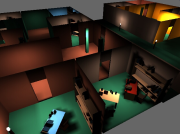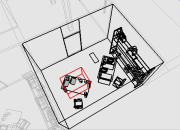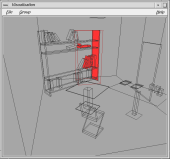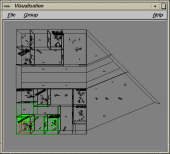Main page for other related papers
Publication
D. Meneveaux, K. Bouatouch, G. Subrenat, P. BlasiProceedings of AFRIGRAPH 2003,
February 2003
Cape Town, South Africa
Abstract
Using a radiosity method to estimate light inter-reflections within large scenes still remains a difficult task. The two main reasons are: (i) the computations entailed by the radiosity method are time consuming and (ii) the amount of memory needed is very large. In this paper, we address this problem by proposing a new clustering technique as well as a new method of visibility computation for complex indoor scenes. Our clustering algorithm groups polygons that are close to each other in each room (or corridor) of the building. It relies on a classification method of k-mean type and allows the use of several kinds of distance functions. For each group of polygons (or cluster), we estimate the set of potentially visible clusters with the help of openings such as doors or windows. This computation results in a graph in which the nodes correspond to clusters and the edges express visibility relationships between the corresponding clusters. We use this graph for computing radiosity in complex buildings while reducing both the amount of memory needed and the computing time. Our global illumination method is a MWRA (multi-wavelet radiosity algorithm). Unlike clusterbased radiosity methods, our MWRA does not approximate (but computes accurately) the light energy impinging or leaving a cluster after multiple reflections. We provide results for 3 different test scenes containing a high number of polygons.
Images
Paper
- paper (pdf version)
- bibtex
@InProceedings{meneveaux:03:AFRIGRAPH,
title = { Efficient Clustering and Visibility Calculation for Global Illumination },
author = {Daniel Meneveaux and Kadi Bouatouch and Gilles Subrenat and
Philippe Blasi},
title = {Efficient clustering and visibility calculation for global illumination.},
booktitle = {Afrigraph},
year = {2003},
month = {february},
pages = {87-94},}
- bibtex



